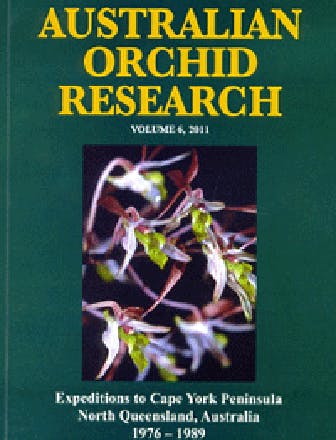This is the sixth volume in the occasional series published by the Australian Orchid Foundation. However, it is the first to concentrate on orchids as a conservation tool. In the introduction Bill Lavarack discusses the history of the series of expeditions led by him for the Queensland National Parks and Wildlife Service during the 1970s and 1980s which led to the establishment of a series of large National Parks spanning the length of the east coast and coastal ranges of northern Queensland. From 1976 until 1989 they were funded by the Australian Orchid Foundation, a magnificent charity which has done so much to encourage and fund Australian orchid research over many years.
Orchid exploration in Cape York began with Joseph Banks who collected Dendrobium canaliculatum and D. discolor when Captain Cook’s Endeavour was beached for repairs caused by running onto the Great Barrier Reef. Little more was achieved until the Archbold Expedition of 1948 when the botanist Len Brass collected 15 more orchid species there. Apart from a few collections by L. Wassell and Mal Brown in the 1950s and 1960s, the Cape remained almost virgin territory for botanical exploration. Bill Lavarack’s passion for orchids changed that by leading a series of expeditions with noted orchid specialists such as David Jones, Bruce Gray and Ben Wallace. He raised the number of orchids reported from Cape York to 128 species. Although notable in itself, the real achievement of Lavarack and his team’s reports was to set the agenda for the raising of National Parks to cover all the richest habitats in the Cape.
The accounts cover seven expeditions conducted between 1976 and 1989, often under great difficulty. The area is difficult to work in, much of the forest grows on rock pile, a treacherous terrain. The rivers which would allow easy access are the home of large estuarine crocodiles which have to be treated with considerable care. Poisonous snakes are also an ever-present hazard. Altogether it is difficult country to negotiate and survive in. Several expedition members suffered illnesses, the worst of which was leptospirosis, and one expedition had to be abandoned as a result.
I must confess that I have a vested interest in these accounts of Cape York, an area I was fortunate to visit with Bill’s 1983 expedition to the Pascoe River. It was a trip that I thoroughly enjoyed, the highlight for me being the discovery of a new species of Habenaria, now named as H. macraithii. The low-point occurred almost simultaneously when I walked into a stinging tree, the effects of which were dramatically painful and lasted for six months.
This record of an exciting series of expeditions and their gratifying outcome is well written and illustrated. Significantly, it demonstrates how important orchid studies can be for conservation. I can recommend this well produced volume without reservation.
Phillip Cribb






